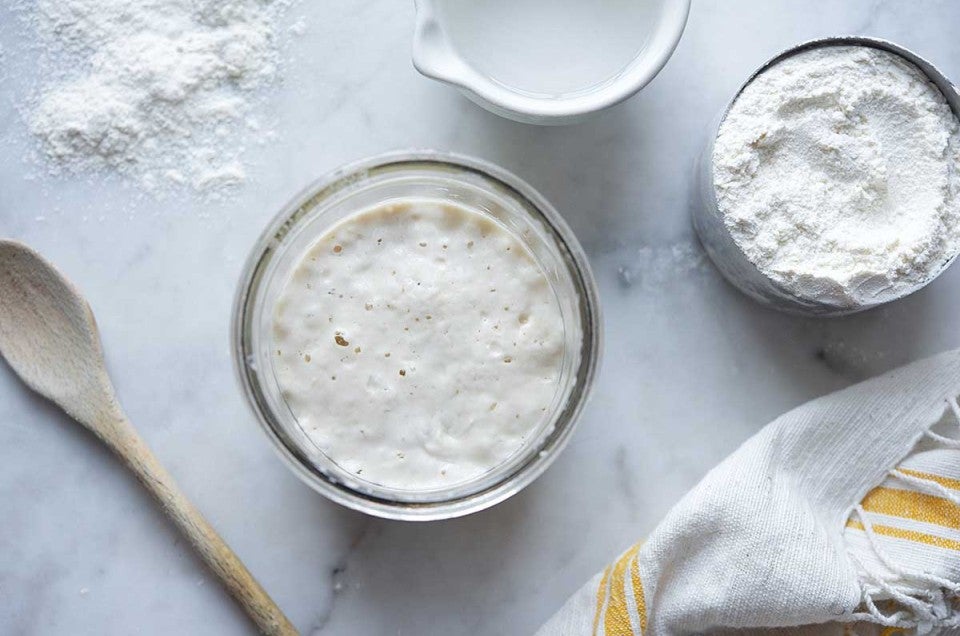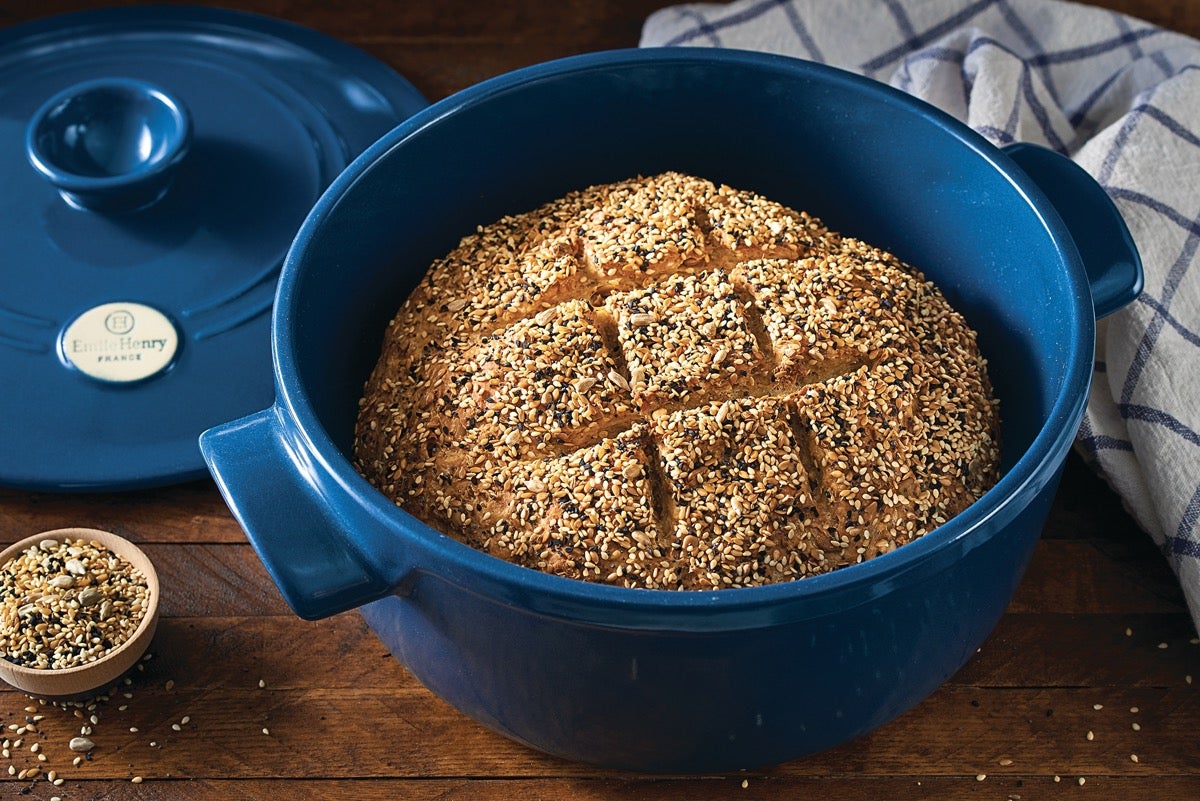


Sourdough baking seems like it should be easy, right? After all, people have been baking naturally fermented bread for thousands of years, and it only requires three ingredients: flour, water, and salt. Well, it’s simple, but creating a starter and baking sourdough bread’s not easy — at least not until you develop your own personal process, something that works for both you and your starter.
Everything from the flour you use to the season of the year to whether you’re urban or rural plays into your sourdough bread success — or less-than-success. Talk about variables!
If you're a new sourdough baker, you may be struggling just trying to get your starter going. The confusion, angst, and even despair that we hear among first-time sourdough bakers out there is truly distressing.
Are you having a rough time with your starter? Let us help. Here are 10 tips directed specifically at brand-new sourdough bakers that should clear up the confusion you’re feeling around not just the starter itself, but the various tools and recipes associated with sourdough baking.
Sourdough starter is a combination of water and flour which, when mixed together, grows wild yeast, produces organic acids, and attracts friendly bacteria. All flours, from whole grain rye to all-purpose white, harbor wild yeast and will cultivate bacteria. But not all flours work the same: some are better right at the beginning of your starter’s life, while others have more to contribute farther along in the process.
Maybe you have a good supply of bread flour but your starter recipe calls for all-purpose (or vice versa). Perhaps the formula lists organic rye flour or golden whole wheat, and you simply don’t have them and can’t get them. No worries; just use what you have.
If your starter calls for all-purpose flour and all you have is bread flour, increase the water a bit; if it calls for bread flour and all you have is all-purpose, decrease the water a bit. And if it calls for whole wheat or rye and you have neither? Your starter may be a bit slower coming to life without the initial “kick” of a whole grain, but eventually it’ll work just fine. (Learn more about how whole grain flours affect starter in our post: Sluggish starter? Add a little whole grain flour.)
One caveat: Bleached flour may eventually yield a decent starter, but due to its natural flora having been killed by bleaching it’ll probably take a heck of a lot longer for a starter made with bleached flour to become fully active.
No, not at all. Our Baking School keeps its starter in food-safe plastic buckets and uses metal spoons or acrylic spatulas to mix it up after feeding. We wouldn’t recommend using a bowl that’ll react with sourdough’s acidity — for instance, don’t mix or store your starter in cast iron or uncoated aluminum — but other than that, glass, plastic, stoneware, acrylic, stainless steel — take your pick, all are acceptable.
No. While chlorine and other chemicals in your treated tap water don’t create the friendliest environment for your starter, there’s no need to make a trip to the store for bottled water.
I’ve successfully used tap water in my starter for years. If your tap water is so heavily treated you can smell the chemicals, try filling an open container and leaving it at room temperature overnight. The next day your water should be good to go.
It’s certainly discouraging to see a starter that’s seemed perfectly happy suddenly turn into a lifeless blob. But it’s OK. As your new starter evolves, one set of bacteria gradually gives way to another; and during that transition, when neither is dominant, your starter will take a rest. Just keep feeding it; within a few days, it should show renewed signs of life.
If you don’t remove some of your starter before feeding it, you’ll soon have gallons of the stuff filling your fridge. So yes, you do have to remove some starter; but you don’t necessarily have to throw it away. Here are your options:
You also have the option of building and maintaining a much smaller starter, one that’s fed and discarded in tablespoons rather than cups. See our recipe for a smaller sourdough starter.
Something with a lid! Seriously, you can go two ways here. If you want to feed and store your starter in the same container, you want one that’s large enough to hold triple your volume of starter. If you’ll be feeding your starter in a bowl and then transferring it to a lidded container to store, the container only needs to be a bit larger than the starter itself.
It’s handy to use a clear glass or translucent plastic container if you’ll be letting your starter rise in it, so you can track its progress. (Our glass sourdough crock is a preferred option.) Stoneware, plastic, stainless steel, and enameled metal are also suitable materials.
Whatever vessel you choose the lid should fit securely, simply to prevent potential spillage if you knock the container over. But you don’t want anything airtight: it’s not necessary and could potentially result in a messy blowout.
Not if you’re going to use it to leaven bread! A fed starter should double in size within 6 to 8 hours, or it probably won’t be strong enough to raise your dough.
Sometimes starter is so thin and liquid-y that there’s not enough structure for it to expand; bubbles simply rise and escape. If your starter seems thin (easily pourable rather than gloppy), try feeding it a bit more flour until it thickens up; alternatively, you can feed it with higher-protein (higher-absorption) bread flour. This might be just what it needs to start growing up, rather than fizzling out.
No, you almost certainly didn’t. While sourdough starter can die under extreme circumstances (e.g., having been fed with boiling water), it’s actually really hard to kill. It may be poky and slow; it may not look like you think it should. But it’s not dead. Keep feeding it on a regular schedule and eventually, it’ll start bubbling again.
Now, sourdough starter can very rarely become “infected” with mold or an evil bacteria, in which case you won’t want to bake with it. If your starter shows evident signs of mold or if it develops a pink/orange tinge, it’s time to discard it and start again.
When it comes to how your starter smells, it's fairly common for a fledgling starter to go through a stinky period (think teenagers' sneakers), but an established starter should never smell awful. That being said, if you've neglected your starter in the refrigerator longer than usual and it smells a little off, a few days of room-temperature feedings will likely restore it to its usual pleasant aroma.
For more on how to assess your starter's health see our post, Sourdough starter troubleshooting.
No. These all come under the heading of nice to have, but not necessary.
A banneton (a.k.a. brotform) is simply a round or oval basket that holds dough as it rises. The risen loaf is then turned out onto a baking stone, a baking sheet, or into a Dutch oven to bake. It’s useful for doughs that are quite soft and need support, keeping them from flattening out as they expand.
You can actually fashion your own rising vessel from a bowl and smooth dish towel, for soft dough. For a stiffer dough, simply allow the loaf to rise on a piece of parchment (which makes it easy to transfer to a hot baking stone); on the baking sheet on which you’ll bake it, or even in your Dutch oven if you decide not to preheat it first.
Rice flour is used to flour your banneton; it’s “slipperier” than regular all-purpose or bread flour and offers better release of the potentially sticky dough but again, not necessary.

A Dutch oven or other closed container is a real boon if you enjoy bread with excellent loft and supremely crusty crust. The container’s lid catches steam from the baking loaf, keeping its top crust soft and allowing it to expand fully. That same steam makes the crust crackly-crisp once the loaf has finished rising and the bread starts to brown.
Yes, a Dutch oven is great to have; see the details here: Bread baking in a Dutch oven. But you can certainly bake a lovely loaf without one.
Our Rustic Sourdough Bread is perfect for beginners. Since it includes a bit of commercial yeast as well as sourdough starter, you don’t have to worry about your starter being totally up to snuff: Call it the belt and suspenders approach. While sourdough purists will argue that using commercial yeast disqualifies your bread as “true” sourdough, hey, what’s in a name? If you enjoy a light-textured, crusty loaf with lovely tang, this one’s for you.
Our Naturally Leavened Sourdough Bread includes no commercial yeast, and relies entirely on a strong starter for its rise. So if you choose this recipe make sure your fed starter is very healthy and active, doubling in size within 6 to 8 hours of feeding. If your starter is ready to go, expect to make a loaf with great crust and chew, and deep, rich sourdough flavor.
The wild yeast and friendly bacteria that bring sourdough starter to life are fickle, just like all living organisms. Sometimes they’re full of energy and ready to rise and shine; other times they need coddling and cajoling. It’s up to you to figure out what your starter needs — and when — in order to keep it happy and working for you.
It sounds daunting, but don’t be discouraged. Gradually, as you learn what works in your kitchen (rather than what works for that guy on YouTube or your best friend in Seattle) you’ll relax and realize that hey, sourdough bread's not that complicated after all. It’s flour, water, salt, and time — both the hours it takes your loaves to rise, and the days you spend learning about this ancient craft through practice, practice, and more practice.
Now, take a deep breath and relax. Your ego should never be tied to how many Instagram likes your bread photo gets, nor should you be discouraged by bread bullies on Facebook dissing that loaf you were so proud of. Always remember: there are no baking police. Plain and simple, if you're happy with the sourdough bread you bake, it's a success.
Want to cut through the clutter of conflicting advice you find online? Read our Guide to Sourdough Baking, a carefully crafted, professionally vetted approach to creating, baking with, and maintaining your own sourdough starter at home. And whatever baking challenge you're experiencing — from a sluggish sourdough starter to cake that caves — call, email, or chat with our Baker's Hotline folks. We're here to help!